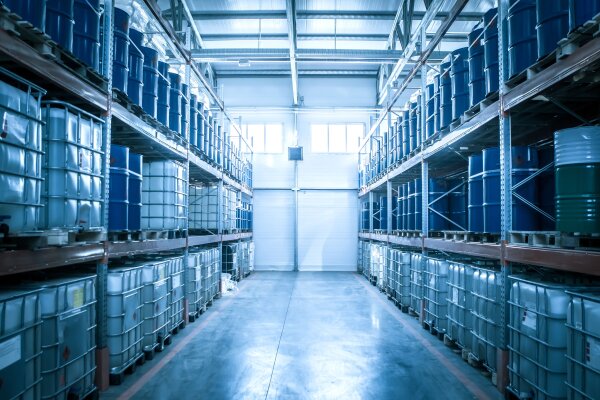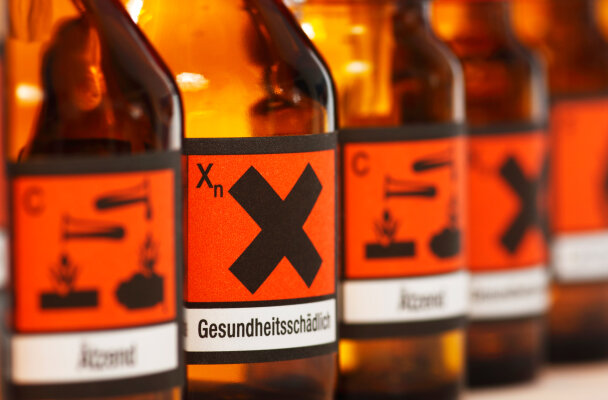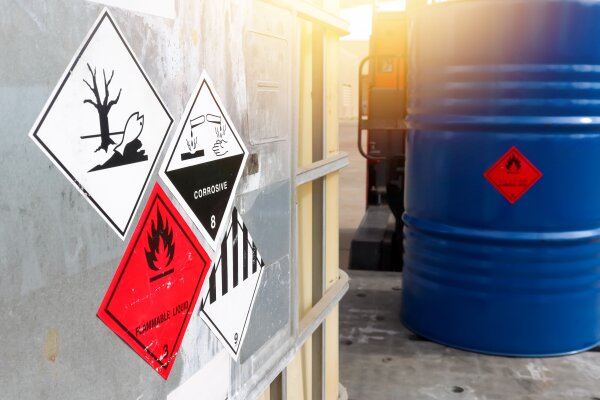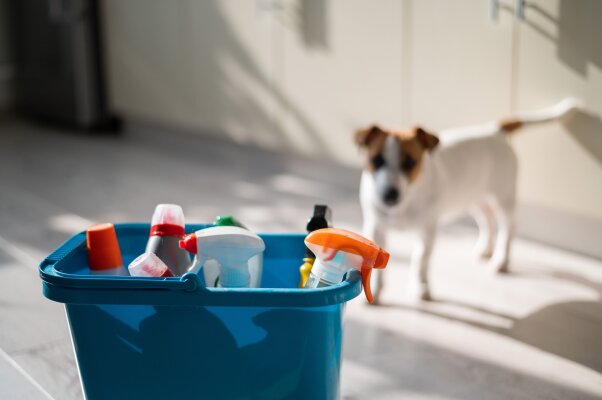Dangerous goods class 9: various dangerous substances and articles

In order to be able to store and transport hazardous materials safely, they are divided into dangerous goods classes in accordance with the ADR Convention. Dangerous goods class 9 accommodates various substances and articles that do not fit into any of the other classes (1 to 8). In this blog post, we have summarized in compact form how Class 9 is defined, what subdivisions apply to it, and what to look out for in terms of legal regulations and labeling.
Dangerous goods class 9: Definition
Unlike the other classes, dangerous goods class 9 is primarily considered a containment class. This means that various substances, objects and hazards are grouped together here – namely those that do not fit into any of the other dangerous goods classes. For the most part, these goods are to be defined as dangerous: Often they are genetically modified or emit flammable vapors. Examples of dangerous goods class 9 include the following:
- Genetically modified microorganisms(ADR subclass M8)
- Lithium batteries (ADR subclass M4), which are also attributed to class 9A.
- Polychlorinated biphenyls (ADR subclass M2)
- Polymers(ADR subclass M3)
- Asbestos(ADR subclass M1)
- Heated substances(such as bitumen or liquid aluminum, ADR subclass M10)
- Rescue equipment, e.g. airbags or belt systems (ADR subclass M5)
Dangerous goods class 9 properties
In addition, different goods and materials are assigned to dangerous goods class 9 if they have special predefined properties. According to the official guidelines, these include in particular:
- They form dioxinsin the event of fire
- In the case of transportation, they pose a danger.
- It is empty and/or uncleaned packaging.
- Although the substances are hazardous, they cannot be assigned to any other ADR class(dangerous goods classes 1 to 8).
- The solid or liquid substances are heated.
- They are lithium batteries or rescue equipment.
Subclasses of hazard class 9
These special properties also form the basis for a further classification – namely thecategorization of dangerous goods class 9into ADR subclasses. The respective classes are marked with the letter “M” as well as a numbering and serve to describe the emanating hazard in more detail:
- M1: Substances that can be inhaled in the form of fine dust and pose a health risk
- M2:Substances that can form dioxins in case of fire
- M3:Substances that give off flammable vapors
- M4: Lithium batteries (both lithium metal batteries and lithium ion batteries)
- M5: Rescue equipment such as airbags and seat belt systems
- M6: Water polluting liquid substances
- M7:Water polluting solids
- M8: Genetically modified microorganisms and organisms
- M9: Heated liquid substances with a heating temperature of more than 100 °C
- M10: Heated solid substances with a heating temperature above 240 °C
- M11: Substances that pose a hazard (like chemistry test kits).
Packing groups of dangerous goods class 9
The substances of dangerous goods class 9 in subclasses M6 to M10 may additionally only be transported in packagings approved by the competent authority. This is due to the environmentally hazardous properties they emit. These substances can be divided into the packing groups that also apply to ADR dangerous goods classes 1 to 8:
Packing group I: Substances with high hazard
Packing group II: Substances with medium hazard
Packing group III:Substances with low hazard
In addition, the third digit of the packaging code number contains a letter that defines more precisely the substance group for which the packaging design is approved: X indicates suitability for all three packaging groups, Y only for groups II and III, and finally Z only for III.
Legal regulations concerning dangerous goods of class 9
All classes of dangerous goods are subject to strict regulations that apply in particular to transport. Therefore, for both storage and transport, several legal regulations must be observed, which should be supplemented by appropriate protective measures.
Regulations and laws
In Germany (and also in Europe), the European Agreement concerning the International Carriage of Dangerous Goods by Road (ADR)is decisive for the transport of substances in dangerous goods class 9. This regulates both the marking (labeling) and the obligations in handling the goods. In addition, there are substance numbers or UN numbers, which are also regulated there. In addition, many other national and international guidelines apply:
- Ordinance on Hazardous Substances
- Council Directive 95/50/EC on uniform procedures for checks on the transport of dangerous goods by road
- RID: Regulation on the International Carriage of Dangerous Goods by Rail
- ADN: European Agreement concerning the Carriage of Dangerous Goods by Inland Waterways
- ICAO-TI: Technical Instructions For The Safe Transport of Dangerous Goods by Air
- IMDG-Code: International Maritime Code for Dangerous Goods
- GGBefG:Dangerous Goods Transport Act
- GGVSEB: Dangerous Goods Ordinance Road, Rail and Inland Navigation
- GGAV:Dangerous Goods Exemption Ordinance
- GbV:Ordinance on Hazardous Goods Officers
- GGKontrollV:Dangerous Goods Control Ordinance
- GGKostV:Dangerous Goods Cost Ordinance
Protective measures against hazardous substances
For the labeling, storage and storage of dangerous goods class 9 substances, protective regulations apply above all for the employer or the workplace. These are anchored in the hazardous substances legislation of the Chemicals Acts and in the Hazardous Substances Ordinance. The legal basis for protective measures for employees can also be found there. Among others, the following aspects are given:
- Avoidance/elimination of sources of danger or exposure potentials:risk assessment and substitute substance testing
- Technical protective measures:Use of closed systems and equipment, extraction of vapors, ventilation and exhaust of work rooms.
- Organizational protective measures:Access restrictions, quantity limits, measurements of limit values.
- Personal protective measures:Protective equipment
- Behavioral protective measures: Instruction and training
Dangerous goods class 9: The mandatory marking
If substances and/or objects of this ADR dangerous goods class are transported in transit, a legally required marking must be affixed. This can be used to indicate that – and, above all, what – danger is posed by this substance.
Both dangerous goods labels and dangerous goods labelsare required, which are available with and without dangerous goods UN numbers. For example, in the event of an accident, arriving rescue and aid forces can immediately assign which measures need to be initiated.
Dangerous goods labels for the transport of substances of ADR class 9
In addition to an appropriate GHS pictogram (think flame for “flammable” or explosion for “explosive”), the following hazardous materials warning label is affixed for Class 9and Class 9A:
.png)
This corresponds to the dangerous goods label and indicates the classification. However, depending on the subclass, the warning panel must be supplemented with additional information. For example, there are special “Miscellaneous” labels in Dangerous Goods Class 9, which are an additional designation indicating these properties:
- Substances that can endanger health when inhaled as particulate matter
- Substances that give off flammable vapors
- Substances and equipment that form dioxins in a fire
Other dangerous goods labels of this dangerous goods class can be classified as follows:
| Class | UN number or description |
| Class 9A | Lithium batteries |
| Class 9A | UN 3090 |
| Class 9A | UN 3091 |
| Class 9A | UN 3480 |
| Class 9A | UN 3481 |
| Class 9 | UN 1805 |
| Class 9 | UN 1845 |
| Class 9 | UN 2315 |
| Class 9 | UN 2990 |
| Class 9 | UN 3077 |
| Class 9 | UN 3082 |
| Class 9 | UN 3090 |
| Class 9 | UN 3091 |
| Class 9 | UN 3166 |
| Class 9 | UN 3171 |
| Class 9 | UN 3245 |
| Class 9 | UN 3257 |
| Class 9 | UN 3268 |
| Class 9 | UN 3363 |
| Class 9 | UN 3432 |
| Class 9 | UN 3480 |
| Class 9 | UN 3481 |
| Class 9 | UN 3509 |
| Class 9 | UN 1845 Dry Ice |
| Class 9 | UN 1845 Dry Ice Shipper's Declaration |
Substances and articles not accepted for carriage
In fact, however, not every substance or object from hazardous substance class 9 is permitted for transport. For example, there are substances that do not meet the requirements according to ADR chapter 3.3 and fall under special provisions 188, 230, 310 or 636. This means that they must not be transported. These substances include, for example:
- Empty collection containers
- Transformers, capacitors and hydraulic devices
- Lithium cells with more than 1g lithium and 20 Wh or with a total amount of 2g lithium and 100 Wh
- Substances with UN numbers 2315, 3151 or 4332
Dangerous goods class 9: special case
Dangerous goods class 9 is a special case among the ADR classes - it includes various substances and objects that do not correspond to any other category. Therefore, proper labeling and appropriate precautions must be taken during transportation and handling, which is specified in particular in the ADR specifications.
Do you have questions about the topic or would you like to suggest a topic? Please feel free to contact us by phone at +49 30 2096579 00 or send us an email to info@medsolut.com.




